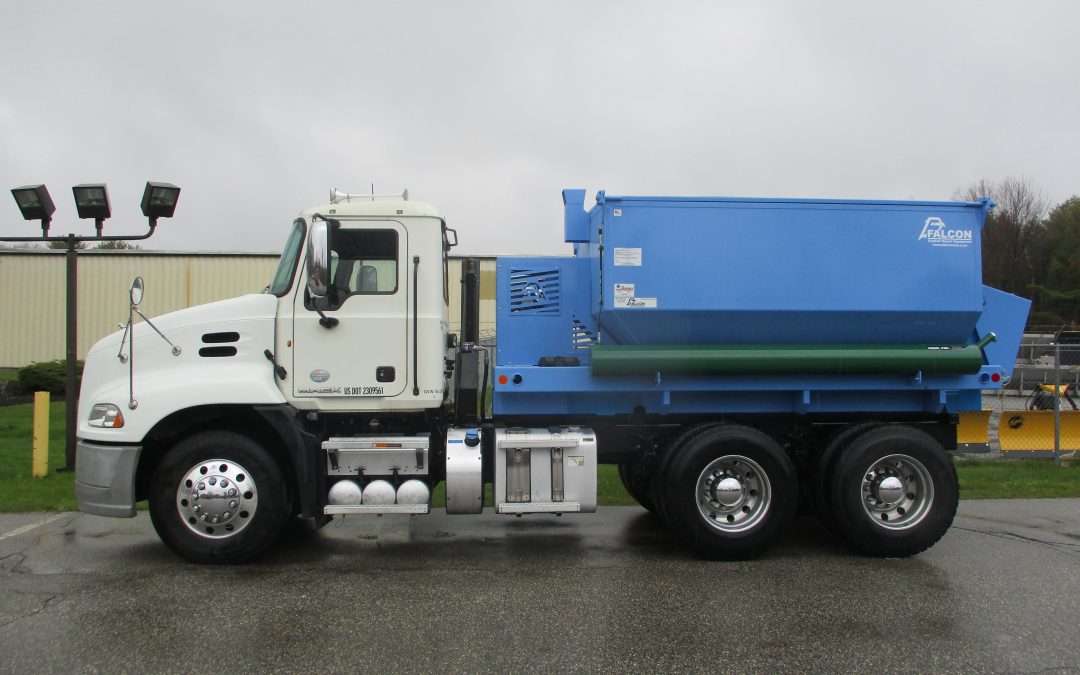Choosing the right patch truck based on capacity impacts everything from crew productivity and licensing requirements to operational efficiency and long-term project success. For municipalities tasked with keeping roads safe and smooth, this decision can directly influence both day-to-day performance and long-term budget planning.
In this guide, we’ll walk you through Falcon’s patch truck capacities — from 2-ton to 8-ton models — and help you determine which size aligns best with your road maintenance volume, crew size, and project scope.
Understanding Falcon’s Patch Truck Capacities
Falcon offers four main patch truck capacities, each with a specific load capacity designed to suit various needs:
2-Ton Patch Truck
Ideal for small municipalities or crews working in tight urban areas with narrow streets and alleys. Its compact size allows for easy maneuvering and a minimal footprint. Because it’s lighter, it can be operated without a commercial driver’s license (CDL), which reduces labor costs and regulatory hurdles. The 2-ton model works best for smaller patching jobs or infrequent repairs where volume is low.
4-Ton Patch Truck
The 4-ton patch truck is Falcon’s most popular mid-range option, offering a balance of capacity and maneuverability. It supports small to medium-sized crews handling regular patching routes. This size is suitable for municipalities with moderate repair demands and can efficiently complete multiple patches before needing to reload. Like the 2-ton, it typically doesn’t require a CDL, easing driver availability concerns.
6-Ton Patch Truck
Designed for larger municipalities or crews with higher daily patching volumes. The 6-ton capacity allows for longer shifts and larger workloads, helping crews maintain productivity without frequent reloads. Depending on local regulations, this model may require a CDL, but its ability to carry more material translates into fewer trips back to the asphalt supply and increased overall efficiency.
8-Ton Patch Truck
This is the largest Falcon Patch Truck, built for the most demanding operations or contractors who handle extensive road maintenance projects. The 8-ton model supports bigger crews and high-frequency patching. It typically requires a CDL and comes with a higher upfront cost, but the efficiency gains, such as completing more patches per day, often justify the investment for larger road networks.
How Capacity Influences Key Operational Factors
Choosing the right patch truck capacity is about more than hopper size—it directly impacts your operations, crew efficiency, and costs. The capacity you select will determine how much asphalt your crew can carry at once, how often they need to reload, and what type of drivers you’ll need.
Making an informed choice here ensures your team stays productive, compliant with regulations, and within budget, ultimately maximizing the return on your equipment investment.
Upfront Cost and Long-Term Savings
Higher capacity patch trucks generally come with a higher purchase price. However, investing in the right capacity can reduce operational costs over time by minimizing downtime and reload trips. Smaller trucks cost less initially but may slow your crew if you regularly exceed their capacity.
CDL Licensing Requirements
Falcon’s 2- and 4-ton Patch Trucks are sized to fall below CDL thresholds, making them ideal for municipalities looking to expand crew flexibility and simplify staffing. Larger 6- and 8-ton models generally require a CDL operator due to weight classifications. If your crew includes a mix of license types, it’s important to weigh the operational and staffing implications of CDL vs. non-CDL patch trucks before choosing a model.
Efficiency and Crew Productivity
Matching capacity to your typical workload ensures crews spend more time patching and less time reloading or waiting. For example, a 2-ton patch truck may require frequent refills during a busy day, whereas a 6-ton truck lets you stay on the job longer without interruption. This increases your daily patch count and reduces downtime.
Maneuverability and Job Site Access
Smaller trucks offer superior maneuverability in tight city streets and alleys, while larger trucks might struggle in those environments. Consider your road layout and site access carefully when deciding on capacity.
Matching Truck Capacity to Maintenance Volume and Frequency
To choose the right patch truck model, start by assessing:
- Road miles maintained: Larger road networks with frequent repairs benefit from bigger capacity trucks.
- Typical crew size: More workers require more material on hand to stay productive.
- Repair frequency: High-frequency patching operations gain efficiency with higher-capacity trucks.
- Repair types:
- Budget constraints: Balance upfront investment with long-term operational savings.
- Licensing and labor availability: Avoid CDL requirements if your team doesn’t have qualified drivers.
For smaller communities or seasonal patching crews, the 2- or 4-ton trucks often provide the best balance of cost, efficiency, and ease of use. Larger city departments or contractors handling many patches daily may find the 6- or 8-ton trucks essential to maintaining high productivity and reducing downtime.
Why Choose Falcon for Your Patch Truck?
At Falcon, we understand the unique challenges municipalities face in road maintenance. Our patch trucks combine innovative design, such as gravity dump systems that reduce maintenance and increase uptime, with flexible capacity options to meet diverse operational needs. We help you make informed, cost-effective decisions to maximize your team’s efficiency and extend the life of your asphalt repairs.
From the smallest 2-ton model to the robust 8-ton trucks, Falcon offers unmatched quality, user-friendly features, and reliable performance. Whether you supply your own truck or choose one of our compatible recommended models, we tailor pothole patching machine solutions to fit your exact needs.
Ready to find the perfect patch truck model?



Recent Comments